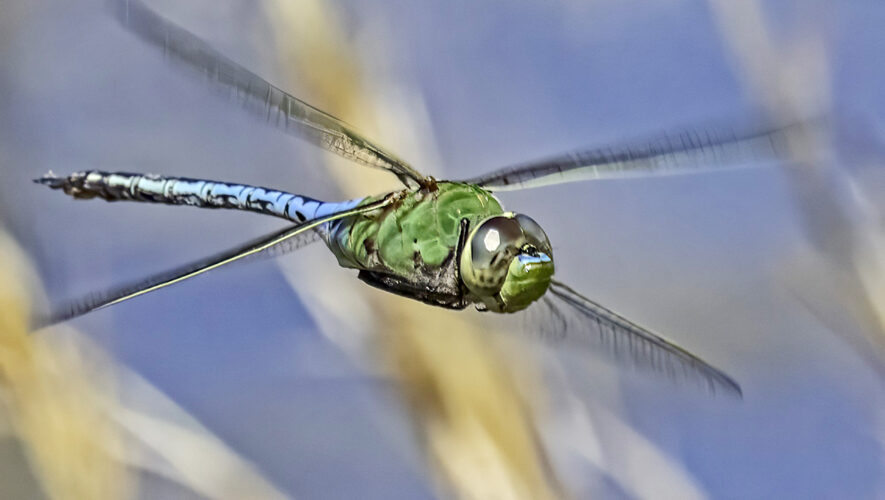If you’re near a pond, stream, or marsh on a warm day, you may notice quick-flying insects skimming across the water or swooping and darting through the air. When they alight, you may be dazzled by their brightly-colored bodies and double sets of lacy wings.
They’re dragonflies and damselflies, fierce predators who are the fastest and most acrobatic insects on Earth. They feed on a variety of smaller insects – including mosquitoes – making them welcome in parks and yards.
Dragonflies and damselflies belong to the taxonomic order Odonata, meaning “toothed one” in Greek – a reference to their serrated mandibles. Affectionately known as “odes” to their fans, dragonflies and damselflies are fascinating to watch.
Dragonflies were among the first winged insects on Earth, emerging some 315 million years ago, about 70 million years before the most ancient dinosaurs! Fossil records show that some early dragonflies had wingspans of up to two feet, possibly due to higher oxygen levels in the air that diffused more efficiently and deep enough into a large-bodied insect. Today’s dragonflies are smaller, but still among the giants of the insect world.
New Jersey has 188 confirmed dragonfly and damselfly species, putting it among the top states in terms of Odonata diversity.
“New Jersey is a very good state for dragonflies,” says Mike Hannisian, the New Jersey editor for the Dragonfly Society of the Americas’ Regional Diversity Project. “For a state our size, it’s an amazing amount.” He noted that California – a much larger but drier state – has only 115 confirmed dragonfly and damselfly species.
Sussex County, our northernmost county, holds a national odes diversity record, with more Odonata species identified there than in any other county in the United States!
Among New Jersey’s most frequently seen odes, said Hannisian, are the common green darner, Eastern pondhawk and blue dasher. The first seen in the spring are usually the blue corporal and fragile forktail, and the most common late in the season is the autumn meadowhawk.
Many dragonfly enthusiasts – including Hannisian and his wife, Nancy – came to their love of odes through birding. While they’re still interested in watching birds, Hannisian noted that odes are easier to photograph – and, thus, identify.
How can you tell a dragonfly from a damselfly? Dragonflies generally have larger and bulkier bodies and hold their wings straight out when at rest. Damselflies tend to be smaller and more delicate, and hold their wings pressed together above their bodies or only partially open while resting.
Though we usually see dragonflies and damselflies only as adults in flight, they actually spend more of their lives underwater as larvae than in the air.
Female dragonflies and damselflies lay their eggs in the water or on plants growing in or next to lakes, ponds, streams, and marshes. The eggs hatch into nymphs, alien-looking aquatic creatures that feed on mosquito larvae, tadpoles, fish, worms and even each other. Depending on latitude, the nymph stage of the life cycle can last from several months to several years.
To complete its metamorphosis, a dragonfly nymph crawls out of the water and onto a rock or stem, where its exoskeleton cracks open and the young adult emerges. Its lace-like wings take anywhere from hours to days to expand, dry and harden. During this period, it’s completely vulnerable to predators.
Once flying, odes have incredible maneuverability, as each of their four wings operates independently. Like helicopters, they can fly forward or backward, hover in place, and fly straight up or down. Some large dragonflies can reach speeds of 35 mph, making them the fastest insects in the world. Odes also have incredible 360-degree vision, thanks to their two enormous compound eyes that cover most of their heads.
As with most insect species, adult odes live only long enough to reproduce – about three to six weeks, during which they feed voraciously. They hunt and eat in midair, and some can consume their body weight in insects each day.
Interested in watching dragonflies and damselflies? The best place to find them is near clean, clear freshwater, like a pond, lake, marsh or stream. Bring close focus binoculars, or a digital camera with close focus capability. Often the differences between closely related species are subtle, and taking high-resolution photos of dragonflies and damselflies is key to identifying them correctly.
A good field guide, like the “Field Guide to the Dragonflies and Damselflies of New Jersey” by Allen E. Barlow, will help you identify species. So will websites like Odonata Central (www.odonatacentral.org) and iNaturalist (www.inaturalist.org), where enthusiasts post photos and observations. Hannisian’s database of New Jersey Odonata flight periods is available through the Dragonfly Society of the Americas website at www.dragonflysocietyamericas.org/en/education.
Dragonfly spotting season generally runs from the first mild days of early spring to the final warm days of early winter. This year’s ode-watching season has gotten off to a slow start due to cool April weather, but Hannisian is expecting a robust season ahead.Enjoy the odes and remember: They need clean water, so protect waterways and marshy habitats near you!
For information about preserving New Jersey’s land and natural resources, visit the New Jersey Conservation Foundation website at www.njconservation.org or contact me at info@njconservation.org.
Alison Mitchell is co-executive director of New Jersey Conservation Foundation. (Photo of common green darter by Mike Hannisian.)


